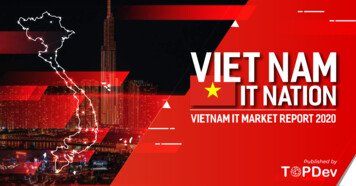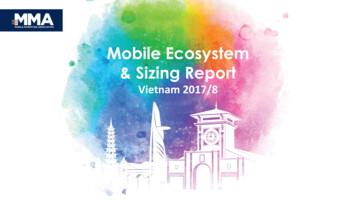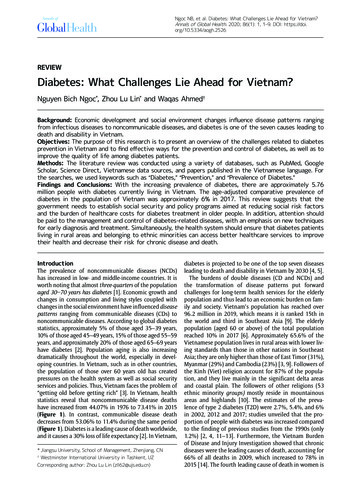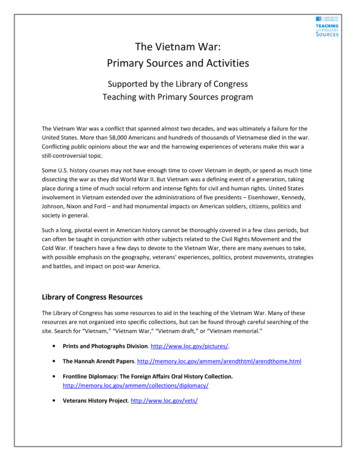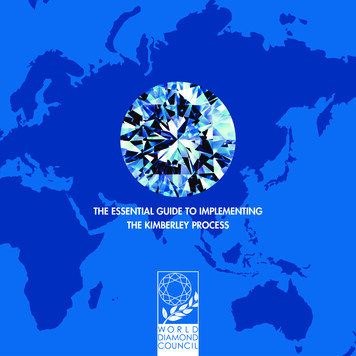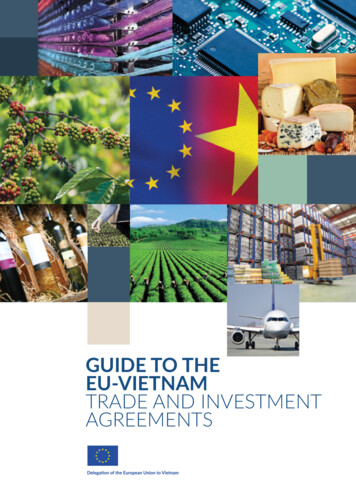
Transcription
GUIDE TO THEEU-VIETNAMTRADE AND INVESTMENTAGREEMENTS
CONTENTINTRODUCTION4Rules of Origin38List of Acronyms4Technical Barriers to Trade40Foreword by Commissioner Malmström6Sanitary and Phytosanitary Measures42Foreword by Ambassador Mr. Bruno Angelet7Intellectual Property Rights44Introduction to the Guide8Geographical Indications48Services, Investment Liberalisation and E-commerce50PART I: EU-VIETNAM TRADE AND INVESTMENT RELATIONS10Government Procurement54Bilateral Trade Relations12Sustainable Development58Bilateral Investment18Renewable Energies60Overview of Vietnam’s Free Trade Agreements20Antitrust, Mergers, State-Owned Enterprises, Subsidies62Trade Remedies64Dispute Settlement65PART III: EU-VIETNAM INVESTMENT PROTECTIONAGREEMENT66Investment Protection Standards68Investment Dispute Settlement70PART IV: USEFUL INFORMATION AND PRACTICAL TOOLS72PART II: EU- VIETNAM FREE TRADE AGREEMENT22Introduction to the Free Trade Agreement24Trade in Goods26Cars30Pharmaceutical Products32Alcoholic Beverages34Customs and Trade Facilitation36
LIST OFACRONYMS4IMDRFInternational Medical Device Regulators ForumIPAInvestment Protection AgreementIPPCInternational Plant Protection ConventionIPRIntellectual Property RightsISOInternational Organization for StandardizationISPIntermediary Service ProvidersITUInternational Telecommunication UnionASEANAssociation of Southeast Asian NationsMEAMultilateral Environmental AgreementBITBilateral Investment TreatyMFNMost Favoured NationBSEBovine Spongiform EncephalopathyOECDOrganisation for Economic Co-operation and DevelopmentCBDUN Convention on Biological DiversityOIEWorld Organisation for Animal HealthCITESUN Convention on International Trade in Endangered SpeciesPCAPartnership and Cooperation AgreementCPTPPComprehensive and Progressive Agreement on Trans-Pacific PartnershipPIC/SCSRCorporate Social ResponsibilityPharmaceutical Inspection Convention and Pharmaceutical InspectionCo-operation SchemeCTHChange of Tariff HeadingPSRProduct Specific RulesDAGDomestic Advisory GroupREXRegistered ExporterEFSAEuropean Food Safety AuthorityRoORules of OriginENTEconomic Needs TestSDRStandard Drawing RightsEUEuropean UnionSMESmall and Medium-sized EnterprisesFDIForeign Direct InvestmentSOEState-Owned EnterpriseFTAFree Trade AgreementSPSSanitary and PhytosanitaryGATSGeneral Agreement on Trade in ServicesTBTTechnical Barriers to TradeGIGeographical IndicationTLTariff LinesGPAGovernment Procurement AgreementUNCITRALUnited Nations Commission on International Trade LawGSOGeneral Statistics Office of VietnamUNECEUnited Nations Economic Commission for EuropeGSPGeneralised Scheme of PreferencesUNFCCCUN Framework Convention on Climate ChangeUPOVInternational Convention for the Protection of New Varieties of PlantsICHConference on Harmonisation of Technical Requirements for Registration ofPharmaceuticals for Human UseWHOWorld Health OrganizationIECInternational Electrotechnical CommissionWIPOWorld Intellectual Property OrganisationILOInternational Labour OrganizationWTOWorld Trade Organization5
The European Union (EU) and Vietnam havingcompleted trade and investment negotiations is goodnews – the kind of thing we both need to ensuresustainable economic growth for our countries andgood, stable jobs for our people.The EU-Vietnam trade and investment agreements arethe most ambitious and comprehensive ones that theEU has ever concluded with a middle-income country.As such, they set a new benchmark for Europe’sengagement with emerging economies. They alsorepresent a great opportunity for European exportersand investors. Vietnam has a vibrant economy of morethan 90 million consumers, a growing middle classand a young, dynamic workforce. It is a market withgreat potential for the EU’s agricultural, industrial andservices exports.Vietnam is also one of the fastest growing countries ofthe Association of Southeast Asian Nations (ASEAN),averaging a GDP growth rate of around 6% for the pasttwo decades and projected to maintain this growth ratein the coming years. Trade-wise, Vietnam has climbedto become the EU’s second biggest trading partner inASEAN after Singapore and ahead of Malaysia, withtrade in goods between the EU and Vietnam worth 48 billion.The free trade agreement (FTA) will put EU exportersand investors at least on a par with those fromother countries and regions which have alreadyconcluded FTAs with Vietnam. These include ASEAN,Australia, New Zealand, Chile, China, India, Japan,and South Korea, and the countries that make up theComprehensive and Progressive Agreement on TransPacific Partnership (CPTPP). At the same time, it will6FOREWORD BYMs. CECILIA MALMSTRÖMFOREWORD BYMr. BRUNO ANGELETEU COMMISSIONER FOR TRADEAMBASSADOR - HEAD OFDELEGATION OF THEEUROPEAN UNION TO VIETNAMput Vietnam in the same league as, for instance, SouthKorea, Japan and Singapore, who have concluded tradeagreements with the EU.The EU - Vietnam Free Trade agreement marks amilestone in our strong and fruitful relationship thatEU Member States and Vietnam have enjoyed forthe past three decades. During this time Vietnamhas experienced remarkable economic growth. Asthe skyline of cities and provinces has transformed,Vietnam continues to demonstrate its globalambition by embracing sustainability and IndustrialRevolution 4.0.The trade agreement seeks to deepen Vietnam’seconomic integration, facilitate trade liberalisationand improve the legal framework for enforcementof standards at both domestic and internationallevel. By taking the advantage of EU’s expertise andtechnological innovation, Vietnam has the opportunityto further the advancement and diversification of itseconomy while improving competitiveness of domesticbusinesses.The EU continues to play a pivotal role in Vietnam’sdevelopment. The EU has been Vietnam’s major donorin grants with over 5 billion over the last decade andis today Vietnam’s biggest non-Asian investor (rankingfifth of total cumulative investment). The EU is Vietnam’sfourth largest trading partner after China, South Korea,and the US, and the second biggest export market forVietnam after the US. Since 2015 Vietnam has beenthe EU’s second biggest trade partner among the 10ASEAN countries (after Singapore) and, amongst them,the largest exporter of goods to the EU.This presents a win-win relationship for both Vietnamand the EU. The trade agreement, together with thePartnership and Cooperation Agreement (PCA) thatentered into force in 2016, consolidates existing areasof cooperation and engagement, and deepens anddiversifies our relations further in areas of mutual interest.Our aim is that, through the trade and investmentagreements, we can encourage more European firmsto be present in Vietnam, and promote better accessfor Vietnamese businesses to the European market. AsVietnam turns into a middle-income country, we share acommon agenda to stimulate growth and employment,improve competitiveness, further fight against povertyand consolidate reform.It will create new opportunities for growth anddevelopment on both sides – for example, by makingcuts in customs duties which will come into forcequickly, while protecting those sectors which areespecially sensitive.The investment protection agreement (IPA) thataccompanies the FTA will help promote high-qualityinvestment between Vietnam and the EU. The EU’supdated approach to investment protection strikesa better balance between boosting job-creatinginvestment and protecting governments’ right topursue policies in the public interest.Moreover, the agreements will promote sustainabledevelopment on both sides and include strongcommitments to protect people’s basic rights at work,their human rights more broadly, and the environment.And it will support Vietnam’s efforts to grow anddevelop its economy for the benefit of its people.After Singapore, Vietnam is the second ASEAN countrywith which the EU has concluded trade and investmentagreements. The agreements are, therefore, alsoan important step towards the EU’s ultimate goal ofsecuring trade and investment agreements with thewhole ASEAN region.The significance of our mutually beneficial relations isclear. Bilateral trade has not only established a strongand productive link between the EU and Vietnam,but has also created an impetus for further economicdevelopment and strategic collaboration amongstthe regions. This momentum is to be bolstered withthe forthcoming signature and implementation of theEU-Vietnam Free Trade Agreement - most ambitiousand comprehensive agreement that the EU has everconcluded with a developing country.We sincerely hope that this pragmatic guide willcontribute to a better understanding of the trade andinvestment agreements between the EU and Vietnam.We have tried to explain in simple and clear language themain outcomes and achievements of the agreementsso that businesses can grasp the opportunities theypresent from day one of their entry into force.7
GUIDE TO THE EU-VIETNAMTRADE AND INVESTMENTAGREEMENTSINTRODUCTIONThe purpose of this publication is to provide first-hand information tobusinesses about the different areas covered by the EU – Vietnam FreeTrade Agreement and Investment Protection Agreement. It has beenprepared to help businesses understand better the main outcomes andachievements of the negotiations.This guide is divided in four parts. The first provides an overview ofbilateral trade and investment relations between the EU and Vietnam.The second and third parts provide a more detailed explanation on whatis actually in the free trade agreement and the investment protectionagreement. Finally, the last part outlines useful information and toolsfor making the most of the opportunities offered by the agreements.The texts of the trade and investment agreements can be found on thewebsite of the European Commission’s Directorate-General for Trade (1).The texts of the agreements presented on the website are, forthe moment, those at the end of the negotiations conducted bythe European Commission and have been made public solely forinformation purposes. The texts are not binding under internationallaw and will only become so after completion of the ratification processby each Party according to their respective internal legal procedures1. am-agreement/89
PART ITRADE &INVESTMENTRELATIONS1011
.853.77108.633.392030Balance of Vietnam’s trade with EU8.433022.19EU exports to Vietnam18.634021.26EU imports from Vietnam7.93.56EU – VIETNAMBILATERAL TRADE ANDINVESTMENT 30Vietnam’s main export markets in 2018(Source: GSO)-26.40-28.70-40200720082009201020112012%5-7%. In 2018, Vietnam’s imports of commodities fromthe EU rose by 11% year-on-year to nearly 12 billionas estimated by Eurostat or 13.1% year-on-year to US 13.8 billion according to Vietnam’s GSO.17%8%19%17%10%8%ChinaJapanUSASouth KoreaEUOtherASEAN1. The Agreement on Market Access or “early harvest agreement” is an offshoot of the bilateral WTO accession deal signed by former EU Trade CommissionerPascal Lamy on his visit to Hanoi, during the ASEM 5 Summit in December 2004. Effective from January 2005, the agreement suspended quotas on Vietnam’sclothing exports to the EU. In exchange, Vietnam commits itself to treat the EU not less favourably than US or Japan. In addition, Vietnam offers companiesof EU origin reduced tariffs on yarns, clothing, fabrics and made-up articles, fibres, beverages, motorbikes as well as manufacturing licenses in the pharma andcement sectors. Vietnam also committed itself to increase market access for service providers in the telecom, construction, computer, engineering, integratedengineering, architecture, and urban planning service sectors. Further licenses are being granted to EU companies in the life insurance, distribution, shipping,computer reservation system, environmental, and real estate service sectors.12-23.65201320142015201620172018Source: GSO / Unit: billion US dollars21On average, Vietnam’s exports of commodities to theEU account for around 19% of its exports to globalmarkets. This figure has seen double-digit growthfor the past decade, annualised at 13-15% and evenreaching 25% in certain years. In 2018, commoditiesexports grew by 11% year-on-year to US 42.5 billionaccording to Vietnam’s General Statistics Office (GSO).It was even larger at around 40 billion according toEurostat. Imports of Vietnamese products into the EUrepresented 2% of the EU’s global imports. Similarly,the past 10 years have seen Vietnam increasingimports of commodities from the EU. This figure hasgrown annually in terms of value by an average of-16.01-21.57BILATERAL TRADE RELATIONSBilateral trade and investment links between the EUand Vietnam have steadily strengthened since the twosides established formal diplomatic relations in 1996.For years, the EU has been the second largest overseasmarket for Vietnamese products and Vietnam’s fourthmost important two-way trading partner after China,South Korea and the US. This has been a dominanttrend since 2004, when the EU and Vietnam concludedthe bilateral negotiations of Vietnam’s accession to theWorld Trade Organization (WTO) – the first bilateralagreement Vietnam had with a big WTO member– and the early harvest agreement1 which enabledmutual market access for the two sides’ companiesthree years before Vietnam became an official memberof the WTO. 2017 witnessed a historical milestone inbilateral trade when Vietnam became one of the tenlargest exporters to the EU for the first time.-15.48The EU is Vietnam’s second largest export market andthe number one destination for many of Vietnam’s keyexports. The figures speak for themselves: in 2018 EUimports of telephone sets from Vietnam were valued atUS 13.12 billion, which represented nearly one thirdof Vietnam’s global exports of telephones. Similarly,its purchase of Vietnamese-made computers andelectronics represented 16% of the country’s revenuesfrom global exports of computers and electronics. Forfootwear such figure was 29%. In addition, the EUhas been the second largest importer of Vietnamesetextiles and garments for a long time (representingnearly 13.5% of Vietnam’s global export in 2018).The EU has been an indispensable market for quite afew Vietnamese agro-products such as coffee (buyingmore than one third of Vietnam’s global coffee exportsin 2018), cashew nuts (nearly 25%), fishery (16%) andwooden products (nearly 10% of its global exports in2018).presence from overseas firms that have invested in thecountry – is exporting to the EU highly sophisticatedproducts such as smartphones, scooters or accessoriesfor transport. Vietnam has, for instance, become ahub of manufacturing for the Italian Piaggio Groupand supplies many brands of modern scooters to Asiaand Europe. Similarly, Samsung’s multi-billion-dollarprojects have turned Vietnam into a regional hub forassembling smartphones, with around one third ofthem exported to Europe. While considerable potentialexists to enhance the position of Vietnamese producersin global production chains, further liberalisation hasbenefited Vietnam’s economy.There have been important shifts in the structure ofVietnam’s exports of commodities to the EU during thepast decades. In 2005, the products mainly comprisedagri-food, footwear and apparels, many of which wereeither in the form of raw materials or simple processingwith little value added. Today, Vietnam – with strong13
Evolution of some Vietnamese key export items to EU from 2007 - 2017Unit: million euro; Source: EurostatVietnam’s main exports to the EU versus its global exports in 2018(Source: Vietnam Customs; Unit: US l products3.000.55Plastic products3.000.55Cashew ats-umbrellas10,0005,000Means of transport& accessories0.61Wood &wooden 2017Wooden furnitureMachinery & Mechanical AppliancesTextiles & .552.04Fisheries2007Vietnam’s exports to the EU3.390.93Machineries & accessories0Vietnam’s global ers& accessories29.324.71Textiles & garments30.454.11Telephone sets& components49.0813.1201020There are three underlying features to the EU-Vietnambilateral trade relations. First, the two partners’economies are strongly complementary. Vietnam’scompetitiveness in the agri-food sector and labourintensive industries is undeniable, while the EU, withits capital, high-tech and top quality managementexpertise, is a competitive and reliable supplier forVietnam. The EU’s ability to supply advance technologiesand sophisticated machineries and equipment matchesVietnam’s needs for its manufacturing sectors. One1430405060example is the nearly 1.45 billion that Vietnam spenton imports of Airbus and accessories from the EU forits air fleet and the US 4.66 billion that Europeanconsumers spent on the purchase of footwear fromVietnam in 2018. Such complementarities will ensuresustainable and healthy growth of bilateral trade tiesin the long run. It was also an important reason behindthe robust double digit growth of Vietnam’s exports tothe EU and imports of commodities from the EU in thepast two decades.15
EU’s main export products to Vietnam in 2017(Source: Eurostat)34.726.329.822.920.625.5198.7%2.1 %2.82.2%Chemical productsPlasticsLeathers & skins2013Machinery & Mechanical appliances201420152016Vehicles%Aircraft & accessoriesOthers.4%-23.918.3%4.816-0.3Electrical equipmentOptical photographic & medical .1-2.921.46-9.952012%Pharma products%2011297.5-30-40Organic ines & ery%Balance of Vietnam’s trade with ASEANBalance of Vietnam’s trade with ChinaBalance of Vietnam’s trade with Japan28.7Balance of Vietnam’s trade with EUBalance of Vietnam’s trade with USABalance of Vietnam’s trade with South Korea2.1%1.6%1.8%Vietnam’s trade balance with main partners 2011 - 2018(Source: GSO; unit: US bilion)2018Source: GSO; unit: USD billionSecond, the solid political relationship and strongcommitments from Europe’s and Vietnam’s leaders actas a crucially important factor for promoting bilateraltrade ties. The EU has long been a supporter ofVietnam’s economic and trade liberalisation. It not onlyprovides considerable concessional loans and grantsto accelerate Vietnam’s reforms and internationalintegration but also offers meaningful and practicalopportunities for Vietnam’s trade to mature. Thisclose political partnership and the strong commitmentto cooperation of the Government of Vietnam hasconvinced the EU to provide as much help as possiblefor Vietnam to develop sustainably. For many years,the EU has offered unilateral preferential treatments toa large number of commodities originating in Vietnamunder the Generalised Scheme of Preferences (GSP).This unilateral scheme has allowed many Vietnameseproducts to be imported into the EU duty-free or withreduced duties.16Lastly, the dynamic and pro-active Vietnamese businesscommunity have undeniably played a decisive role inVietnam’s success in harnessing trade opportunities.Before 1997, it would have been inconceivable thatVietnam would be able to export fishery products tothe EU, let alone have a leading share of the EU market.To give just one example, the quality of managementat some modern fishery processing facilities inSouthern Vietnam is high. The success in exportingits fishery products to the EU, with its high sanitaryand phytosanitary standards, has enabled Vietnam tounlock other key markets such as Japan and the UnitedStates. Vietnam is witnessing similar success storieswith electronics and computers, telephones, footwear,textiles and garments etc. The EU-Vietnam trade andinvestment agreements will create the momentumto further strengthen the already robust trade andinvestment ties between the EU and Vietnam.17
BILATERAL INVESTMENTTotal cumulative n6793.58Czech enty-four EU Member States now have FDIprojects in the country. Among the Member States,the Netherlands with nearly US 9.33 billion in capitaland 318 projects is taking the lead as the biggest FDIpartner. France ranks second with nearly US 3.62billion and 525 projects, followed by the UK with nearlyUS 3.49 billion in capital and 340 projects.Committed FDI in 2018Unit: million US 7000Source: Foreign Investment Agency, MPI6000500040003000200010001068.3No. of ProjectsProvince. Ho Chi Minh City ranks first as the mostattractive destination for European investors with 833projects worth US 3.584 billion, trailed closely byHanoi (capital: US 3.74 billion; number of projects:478) and Ba Ria Vung Tau Province (capital: US 3.68billion; number of projects: 40).Most of the EU-invested projects are located in placeswhere infrastructures are well developed, such asHanoi capital city, Quang Ninh Province and in thebusiness hub in Southern Vietnam, including Ho ChiMinh City, Ba Ria Vung Tau Province and Dong Nai1128.9EU Member StatesUnit: million US 1217.1Cumulative Foreign Direct Investment from EU into Vietnam1423.6European investors have been active in all 18 economicsectors and present in 52 out of the 63 provinces andmunicipalities of Vietnam. The three most prominentsectors are manufacturing, electricity production andtransmission, and real estate. In the manufacturing sector,EU investors have had 652 projects with investmentscapital worth more than US 8.4 billion, followed by theelectricity production and transmission sector (FDI: US 5billion; number of projects: 26) and real estate (capital:US 2.66 billion; number of projects: 52).3657.62133 projects in Vietnam, making the EU the 5th largestFDI partner in terms of total stock. In 2018 alone,European investors poured nearly US 1.1 billion.6592.1The EU has been an important source of investment forVietnam since the country opened its economy to theworld. In terms of cumulative investments, the EU ranksfifth out of Vietnam’s 80 Foreign Direct Investment(FDI) partners. By the end of 2018, investors from theEU had invested more than US 23.927 billion egapHonSouSource: Vietnam Foreign Investment AgencySinKorea23,927.35th2,133JapTotalan019
OVERVIEW OF VIETNAM’s FTAs WITH OTHER PARTNERS1.Vietnam – Japan Economic Partnership Agreement (EPA)Status: signed in December 2008, in force since 1 October 20092.Vietnam – Chile FTAStatus: signed on 11 November 2011, in force since 1 January 20143.4.Comprehensive and Progressive Agreement on Trans-Pacific PartnershipStatus: signed in 8 March 2018, seven including Vietnam have ratified the CPTPP by January 2019Members: Australia, Brunei, Canada, Chile, Japan, New Zealand, Peru, Singapore, Malaysia, Mexicoand VietnamVietnam – Eurasia Economic UnionStatus: signed on 29 May 2015, will enter into force 60 days after the final member country ratifies the FTAMembers: Vietnam, Russia, Belarus, Armenia, Kyrgyzstan and Kazakhstan5.Vietnam – EFTA (European Free Trade Association)Status: negotiations launched in April 2012, still going onMembers: Vietnam, Switzerland, Iceland, Norway and Lichtenstein6.Vietnam – South KoreaStatus: signed on 5 May 2015, in force since 20 December 20157.Vietnam - European Union FTAStatus: concluded in December 2015; expected to be signed in 2019ASEAN FTAs201.ASEAN Free Trade AreaStatus: signed, in effect since 30 January 20032.ASEAN – China FTAStatus: signed, in effect 20033.ASEAN – Japan FTAStatus: in effect since December 20094.ASEAN – India FTAStatus: in effect since January 20105.ASEAN – Australia and New Zealand FTAStatus: in effect since January 2010 (Laos, Cambodia and Indonesia in effect since 2011 and 2012)6.ASEAN – South Korea FTAStatus: Trade in goods chapters signed in August 2006; trade in services signed in November 200721
PART IIEU-VIETNAMFREE TRADEAGREEMENT2223
INTRODUCTIONTO THE FTAThe European Union manages trade relationswith countries outside the EU through its tradepolicy. Trade policy is an exclusive competenceof the EU – so only the EU, and not individualMember States, can legislate on trade mattersand negotiate international trade agreements, bethey multilateral, regional or bilateral.Economic relations between ASEAN and the EUhave proven to be mutually beneficial. The EUhas always been an important trading partnerfor ASEAN, and vice versa. ASEAN is a key pillarof growth in Asia and a market of enormouspotential. Strengthening trade relations betweenthe EU and ASEAN is of importance to bothregional blocs. The EU is ASEAN’s second largesttrading partner after China and by far the largestinvestor. ASEAN is the EU’s third largest tradingpartner outside Europe after the US and China.As highlighted in the European Commission’strade strategy ‘Trade for all’1, strengthening traderelations with ASEAN remains a key priority forthe EU. The EU is fully engaged with ASEAN andits member countries in pursuing an ambitioustrade agenda. The EU has concluded trade andinvestment negotiations with Singapore and withVietnam, and has in the meantime also launchedtrade and investment negotiations with Malaysia(2010), Thailand (2013), the Philippines (2015)and Indonesia (2016). At regional level, theultimate objective is for the bilateral trade andinvestment agreements under negotiation toserve as building blocks towards an ambitious andcomprehensive EU-ASEAN regional agreement.FTA INSTITUTIONAL SET-UPSpecialised Committee on CustomsSpecialised Committee on Sanitaryand Phytosanitary MeasuresWorking Group on MotorVehicles and PartsSpecialised Committee on Trade andSustainable DevelopmentWorking Group on IPR/GlsSpecialised Committee onInvestment, Trade in Services,Electronic Commerce andGovernment ProcurementSpecialisedCommittee onTrade in GoodsTRADE COMMITTEETrade and investment agreements aimfundamentally at obtaining preferential treatmentfor goods and services and eliminating non-tariffbarriers encountered by both sides. They also setup a clear and transparent legal framework togovern trade and investment relations betweenboth trade partners. Knowing the rules of thegame is vital for businesses as it provides stabilityand predictability and allows them to make longterm plans.For the past years, Vietnam has enjoyedpreferential access to the EU through theGeneralised Scheme of Preferences granted bythe EU to developing countries. With the tradeagreement, the EU and Vietnam have offeredeach other preferential access to their respectivemarkets in a predictable manner.Last but not least, this trade agreement is alsosignificant because of its emphasis on sustainabledevelopment with strong commitments onfundamental labour rights and environmentalprotection. Respect for human rights is alsoembedded in the agreement. It will supportVietnam’s efforts to further enhance economicgrowth and development for its people in theyears to come.Institutional structureof the EU – Vietnam FTAA Trade Committee, in addition tospecialised committees and workinggroups, will be responsible for ensuringthe proper operation of the EU – VietnamFTA. The different bodies provide anopportunity both to seek resolution ofmarket access concerns and to engage incloser regulatory cooperation.Meeting annually, the Trade Committeewill be co-chaired by the Minister forIndustry and Trade of Vietnam and theMember of the European Commissionresponsible for Trade, or their respectivedesignees. The Trade Committee willmanage the agreement.The EU – Vietnam FTA also foreseesthe establishment of five specialisedcommittees and two working groups,which will meet in principle once a year.The Trade Committee may decide toestablish other specialised committeesand working groups to assist it in its tasks.1. /tradoc 153846.pdf* IPR/GIs intellectual property rights / geographical indications2425
TRADEIN GOODSTariff elimination by Vietnam for EU products(Value in % accumulated)86.7%90%80%67.7%70%60%54.7%50%Tariff elimination31.3%40%28.5%15.2%30%Improved market access is one of the key objectives of any trade agreement. The EU-Vietnam trade agreementcontains full dismantling of nearly all tariffs except for a few tariff lines that are subject to duty-free tariff rate quotas.20%Widespread coverage is achieved already at entry into force with 65% of EU exports to Vietnam coming in duty- freefrom day one. The remaining trade – with the exception of a few products – will be liberalised after 10 years. The EUwill liberalise 71% of its imports from Vietnam from day one and 99% will enter duty-free after seven years.0%10%0.4%Y0Y3Y517.9%0.4%4.7%Y7Custom duties will be removed over a transitional period (of a maximum period of seven years for Vietnamesegoods and 10 years for EU goods) so that domestic producers can gradually adapt. Consumers from both sideswill benefit from lower prices and exporters from strengthened ial productsFisheryAgricultureY10*EXAMPLES OF BENEFITS FROM TARIFF ELIMINATION FOR EU EXPORTERSEXAMPLES OF MARKET ACCESS PREFERENCES GRANTED BY THE EU TO VIETNAM Almost all EU exports of machinery and appliances will be fully liberalised at entry into force of the FTA. EU duties on textile apparel have dismantling periods stretching from five to seven years for the mores
is actually in the free trade agreement and the investment protection agreement. Finally, the last part outlines useful information and tools for making the most of the opportunities offered by the agreements. The texts of the trade and investment agreements can be found on the website

